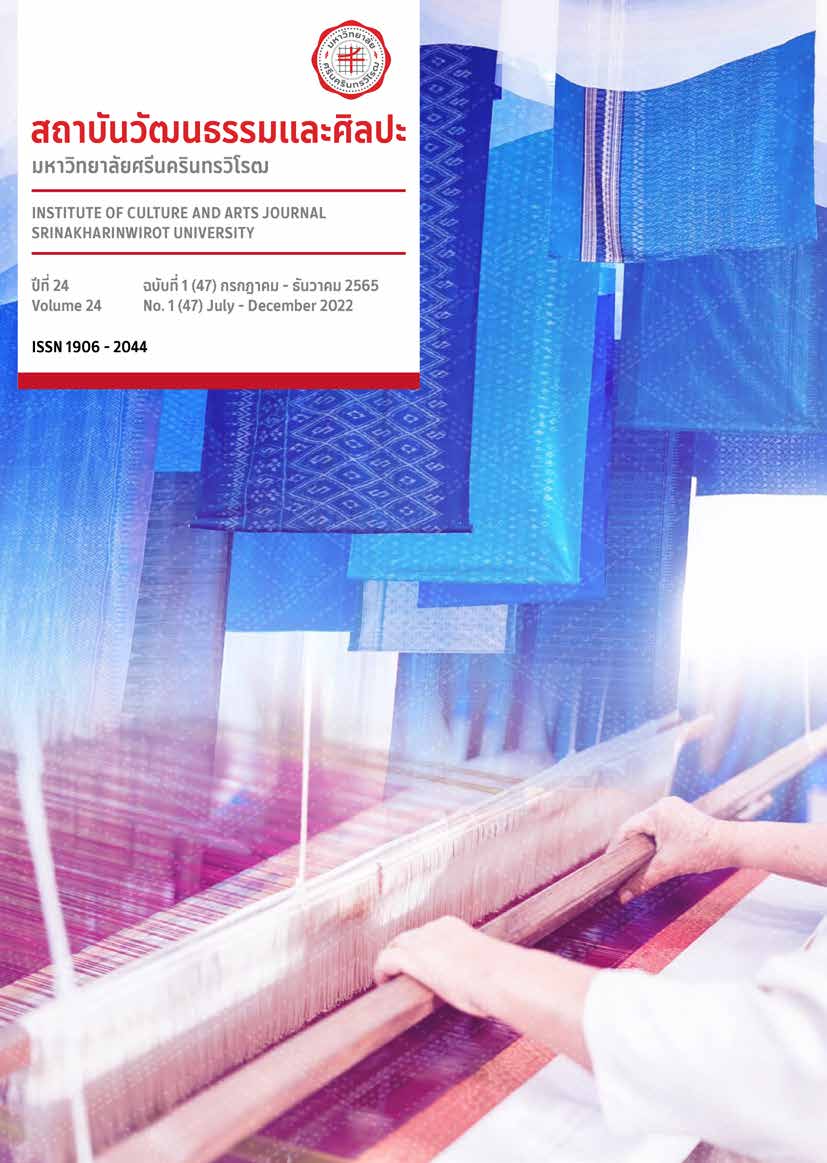อัตลักษณ์วัฒนธรรมอาหารลังกาสุกะแห่งดินแดนปลายด้ามขวานของประเทศไทย
คำสำคัญ:
วัฒนธรรมอาหาร , อัตลักษณ์อาหารลังกาสุกะ , ลังกาสุกะ , สามจังหวัดชายแดนใต้ , การท่องเที่ยวเชิงอาหารบทคัดย่อ
การศึกษาวิจัยนี้ เป็นการศึกษาด้วยวิธีการวิจัยเชิงคุณภาพจากการสังเคราะห์เอกสาร และการสัมภาษณ์เชิงลึกผู้ให้ข้อมูลหลัก จำนวน 23 คนในพื้นที่จังหวัดปัตตานี จังหวัดยะลา และจังหวัดนราธิวาส เพื่อมุ่งหาอัตลักษณ์อาหารลังกาสุกะ และเมนูอาหารลังกาสุกะ ในสามจังหวัดชายแดนใต้ ผลการวิจัยพบว่าอัตลักษณ์อาหารลังกาสุกะเกิดจากองค์ประกอบ 4 ด้านประกอบด้วย (1) การเลือกใช้อาหารทะเลตามฤดูกาลจากวัตถุดิบท้องถิ่น (2) เครื่องปรุงที่มีเอกลักษณ์ ได้แก่ เกลือหวาน เครื่องเทศ มะพร้าว กะทิ น้ำตาลต่าง ๆ (3) อิทธิพลความหลากหลายทางเชื้อชาติ และศาสนา และ (4) การได้รับการถ่ายทอดมรดกภูมิปัญญาจากบรพบุรุษ และส่งมอบไปยังรุ่นสู่รุ่น นอกจากนี้ผลการวิจัยพบว่าเมนูอาหารลังกาสุกะ 34 เมนู ส่วนใหญ่เกิดจากการผสมผสานทางวัฒนธรรมและภูมิปัญญาเดิมของผู้คนในพื้นที่สามจังหวัดชายแดนใต้ และรองลงมาได้รับอิทธิพลมาจากชวา (อินโดนีเซีย) อินเดีย อาหรับ โปรตุเกส และจีน
Downloads
เอกสารอ้างอิง
กองยุทธศาสตร์และแผนงานสำนักงานปลัดกระทรวงพาณิชย์. (2560). แผนแม่บทภายใต้ยุทธศาสตร์ชาติ (5) ประเด็น การท่องเที่ยว (พ.ศ. 2561-2580). http://nscr.nesdb.go.th/wp-content/uploads/2019/04/05-%E0%B8%81%E0%B8%B2%E0%B8%A3%E0%B8%97%E0%B9%88%E0%B8%AD%E0%B8%87%E0%B9%80%E0%B8%97%E0%B8%B5%E0%B9%88%E0%B8%A2%E0%B8%A7.pdf
คณะกรรมการยุทธศาสตร์ชาติ. (2560). ยุทธศาสตร์ชาติ พ.ศ. 2561-2580 (ฉบับประกาศราชกิจจานุเบกษา). http://planning.dld.go.th/th/index.php/th/plan-menu/746-2561-2580
ครองชัย หัตถา. (2551). ประวัติศาสตร์จังหวัดปัตตานี: สมัยอาณาจักรโบราณถึงการปกครอง 7 หัวเมือง สำนักพิมพ์แห่งจุฬาลงกรณ์มหาวิทยาลัย. ประเทศไทย
ชินีเพ็ญ มะลิสุวรรณ, มีนา ระเด่นอาหมัด. (2564). การสื่อสารวัฒนธรรมอาหารพื้นบ้านชายแดนใต้ของไทย. Panyapiwat Journal, 13(2), 177-189. https://so05.tci-thaijo.org/index.php/pimjournal/article/view/251134.
ณัฐชา ตะวันนาโชติ (2563/6/สิงหาคม). Making sense: รับรู้และรู้สึก. https://web.tcdc.or.th/th/Articles/Detail/Making-Sense.
ทรงสิริ วิชิรานนท์ และคณะ (2555). วิถีชีวิตและความมั่นคงทางอาหารท้องถิ่นภาคใต้. วารสารวิจัยและวิชาการมทรพระนคร มหาวิทยาลัยเทคโนโลยีราชมงคลพระนคร. 8(1). 94-107. https://ph02.tci-thaijo.org/index.php/RMUTP/article/view/18932/16696.
นิปาติเมาะ หะยีหามะ และคณะ. (2562) การจัดการทางวัฒนธรรมการอนุรักษ สืบสานอาหารพื้นบ้านตำบลประจัน. ภายใต้โครงหารวิจัยและพัฒนาสุขภาวะชุมชนท้องถิ่นสามจังหวัดชายแดนใต้. ทุนสนับสนุนจากสำนักงานสุขสภาวะชุมชน (สำนัก 3) สำนักงานกองทุนสนับสนุนการสร้างเสริมสุขภาพ (สสส.)
นูรอา สะมะแอ, & นันทนา วงษ์ไทย. (2560) การศึกษาคำเรียกการทำอาหารหวานในภาษามลายูปา ตานีเชิงอรรถศาสตร์ชาติพันธุ์.วารสารศิลปศาสตร์ มหาวิทยาลัยสงขลานครินทร์ วิทยาเขตหาดใหญ่.9(2), 140-164. http://wb.yru.ac.th/handle/yru/788
พัชรี กล่อมเมือง. (2019). "คนชายขอบ: ชาวไทยเชื้อสายมลายูในสามจังหวัดชายแดนภาคใต้." Academic Journal Bangkokthonburi University 8, no. 2 1-10.
พิมพ์อักษรา หรูประกายอักษร. (2015). การธำรงอัตลักษณ์ทางชาติพันธุ์ภายใต้กระบวนการเรียนการสอนในศูนย์คาทอลิกนักบุญอันนาเพื่อเด็กอพยพย้ายถิ่นอำเภอเมืองจังหวัดสมุทรสาคร.[วิทยานิพนธ์ปริญญามหาบัณฑิต]. มหาวิทยาลัย ศิลปากร. http://www.sure.su.ac.th/xmlui/bitstream/handle/123456789/15088/BA_Pimauksara_Rooprakaiauksorn.pdf?sequence=1
พิสิทธิ์ ศรีประเสริฐ. (2561). อาหารไทย: การนำเสนออัตลักษณ์อุดมการณ์ความเป็นไทยและวาทกรรมเชิงอานาจ. วารสารการสื่อสารมวลชน มหาวิทยาลัยเชียงใหม่., 6 (1). https://so03.tci-thaijo.org/index.php/masscomm/article/view/131018.
ลออแมนและอารีฟิน. (2541). ลังกาสุกะ จังหวัดปัตตานีดารุสลาม ศูนย์วัฒนธรรมชายแดนภาคใต้. สำนักพิมพ์เจริญผล. จังหวัดยะลา
ศรุดา นิติวรการ (2557) อาหารไทย: มรดกทางวัฒนธรรมของชาติ. Academic Journal Phranakhon Rajabhat University, 5(1), 171-179. https://so01.tci-thaijo.org/index.php/AJPU/article/view/42173
ศศิกาญจน์ นารถโคษา (2556). โครงการออกแบบและพัฒนาผลิตภัณฑ์ตกแต่งสวนที่สะท้อนอัตลักษณ์ไทย. [วิทยานิพนธ์ปริญญามฟาบัณฑิต]. มหาวิทยาลัยศิลปากร. http://www.sure.su.ac.th/xmlui/bitstream/handle/123456789/13567/fulltext.pdf?sequence=2
สุดถนอม ตันเจริญ. (2021). อัตลักษณ์กลุ่มชาติพันธุ์อำเภออู่ทองจังหวัดสุพรรณบุรี. Journal of Human Sciences, 22(2), 233-252. https://so03.tci-thaijo.org/index.php/JHUMANS/article/view/244015
Almerico, G. M. (2014). Food and identity: Food studies, cultural, and personal identity. Journal of International Business and Cultural Studies, 8, 1. https://citeseerx.ist.psu.edu/viewdoc/download?doi=10.1.1.645.8411&rep=rep1&type=pdf.
Altugan, A. S. (2015). The relationship between cultural identity and learning. Procedia-Social and Behavioral Sciences, 186, 1159-1162. doi: 10.1016/j.sbspro.2015.04.161
Amiot, C. E., Doucerain, M. M., Zhou, B., & Ryder, A. G. (2018). Cultural identity dynamics: Capturing changes in cultural identities over time and their intraindividual organization. European Journal of Social Psychology, 48(5), 629-644.
Belma, S. U. N. A., & Alverez, M. D. (2019). Gastronomic identity of Gaziantep: Perceptions of tourists and residents. Advances in Hospitality and Tourism Research (AHTR), 7(2), 167-187. DOI: 10.30519/ahtr.571666
Berlo, D. K. (1977). Communication as process: Review and commentary. Annals of the International Communication Association, 1(1), 11-27. DOI: 10.1080/23808985.1977.11923667
Dietler, M. (2007). 11. Culinary Encounters: Food, Identity, and Colonialism. The archaeology of food and identity. 1218. 218-242. https://www.academia.edu/download/31271537/Dietler.ArchFood07.pdf.
Grimaldi, P., Fassino, G., & Porporato, D. (2019). Culture, heritage, identity and food. A methodological approach. the European Union European Regional Department Fund. https://foodpathsnetwork.slowfood.com/wp-content/uploads/2019/12/Culture-Heritage-Identity-and-Food-A-Methodological-Approach.pdf
Ishak, N., Zahari, M. S. M., Talib, S. A., & Hanafiah, H. M. (2019). The influence of biculturalism/integration attributes on ethnic food identity formation. Journal of Ethnic Foods, 6(1), 1-13. https://doi.org/10.1186/s42779-019-0024-4
Korsmeyer, C., & Sutton, D. (2011). The sensory experience of food. Food, Culture & Society, 14(4), 461-475. DOI: 10.2752/175174411X13046092851316
Lindstrom, M. (2005). Broad sensory branding. Journal of Product & Brand Management.
Nopsuwan, N., Kheokao, J., Phovijit, P., PornsuksawatLangkasuka, S. (2022). Food tourism: A systematic review for food and cultural identity framework reconstruction. In Papasolomou, I., & Melanthiou, Y., (Eds.), Digital technologies in light of covid-19. CMC2022 26th Corporate and marketing communications conference. (pp.100-110). https://www.unic.ac.cy/cmc2022/wp-content/uploads/sites/33/2022/05/Book-of-Proceedings-CMC2022.pdf
Morales, O., & Cordova, C. (2019). Gastronomy as a national identity element: the Peruvian case. In Diversity within Diversity Management (Vol. 21, pp. 157-174). Emerald Publishing Limited.Pak, 2021. Doi:10.1108/S1877-636120190000021009
Parasecoli, F. (2014). Food, identity, and cultural reproduction in immigrant communities. social research, 81(2), 415-439. Retrieved from https://www.jstor.org/stable/26549625
Renard, M. C., & Thomé, H. (2016). Cultural heritage and food identity: The pre-Hispanic salt of Zapotitlán Salinas, Mexico. Culture & History Digital Journal, 5(1). http://dx.doi.org/10.3989/chdj.2016.004
Sebastia, B. (2016). Eating traditional food: politics, identity and practices. In Eating Traditional Food (pp. 15-33). Routledge. https://www.ifpindia.org/media/documents/2020_05_07_eating_traditional_food_WcDzzUZ.pdf
Sibal, V. (2018). Food: identity of culture and religion. Scholarly Research Journal for Interdisciplinary Studies, 6(46), 10908-10915.
Sutton, D. E. (2010). Food and the Senses. Annual review of anthropology, 39, 209-223. Retrieved from https://www.academia.edu/1479651/Food_and_the_Senses
Taylor, D. M., & Kachanoff, F. J. (2015). Managing cultural diversity without a clearly defined cultural identity: The ultimate challenge. Peace and Conflict: Journal of Peace Psychology, 21(4), 546. http://dx.doi.org/10.1037/pac0000131
Teeaw, A. and Wyatt, D.K. (1970). Hikayat Pattani: the story of Pattani. Spring Science Business Media Dordrecht.
Williams-Gualandi, D. (2020). The cultural group in intercultural understanding: implications for teaching from a social identity theory perspective. Journal of Research in International Education, 19(3), 233-250. https://doi.org/10.1177/1475240920978712
Yaisumlee, T., Thanyakit, S., Sakmunwong, C., & Peatrat, N. (2019). “แกงฮังเล” วัฒนธรรม และความเชื่อ. Valaya Alongkorn Review, 9(2), 172-186. https://so06.tci-thaijo.org/index.php/var/article/view/213511.
Zhang, F. F., Roberts, S. B., Must, A., Wong, W. W., Gilhooly, C. H., Kelly, M. J., & Saltzman, E. (2015). Assessing dietary intake in childhood cancer survivors: food frequency questionnaire versus 24-hour diet recalls. Journal of pediatric gastroenterology and nutrition, 61(4), 499. Doi: 10.1097/MPG.0000000000000826
Zhang, G., Chen, X., Law, R., & Zhang, M. (2020). Sustainability of heritage tourism: A structural perspective from cultural identity and consumption intention. Sustainability, 12(21), 9199. doi:10.3390/su12219199
ดาวน์โหลด
เผยแพร่แล้ว
รูปแบบการอ้างอิง
ฉบับ
ประเภทบทความ
สัญญาอนุญาต
ลิขสิทธิ์ (c) 2022 วารสารสถาบันวัฒนธรรมและศิลปะ

อนุญาตภายใต้เงื่อนไข Creative Commons Attribution-NonCommercial-NoDerivatives 4.0 International License.
บทความทุกบทความที่ได้รับการตีพิมพ์ถือเป็นลิขสิทธิ์ของวารสารสถาบันวัฒนธรรมและศิลปะ มหาวิทยาลัยศรีนครินทรวิโรฒ



